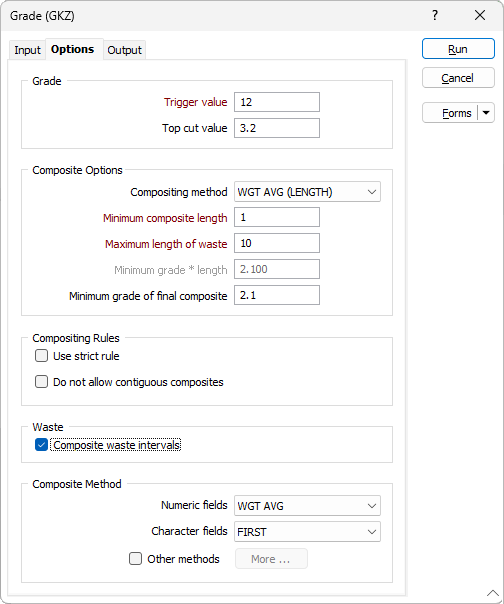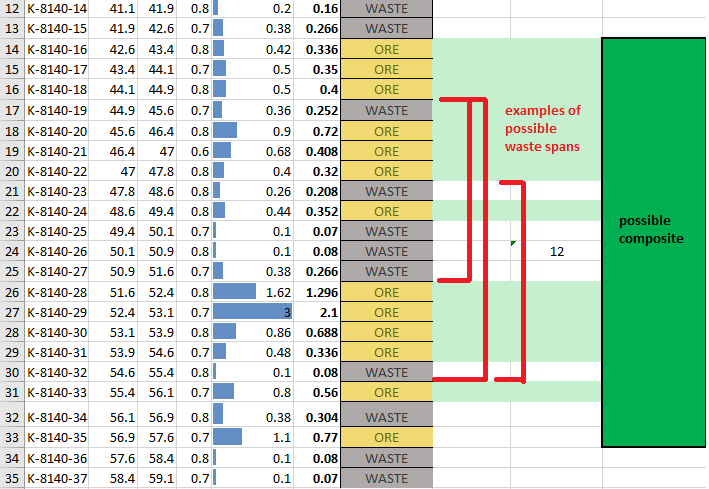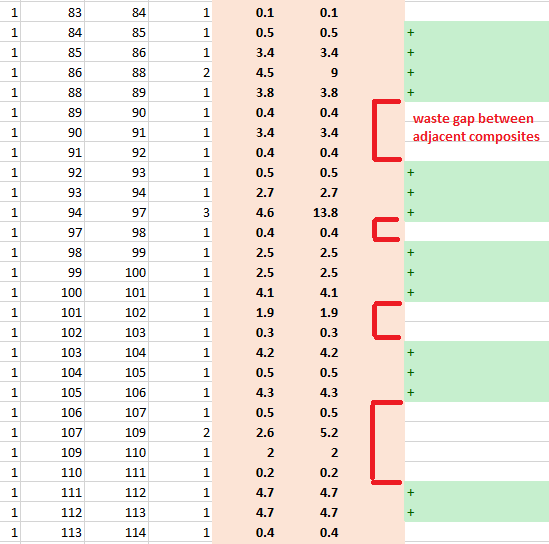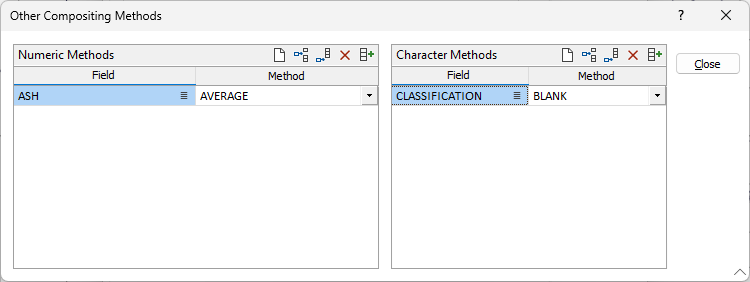Options
On the Options tab of the Grade Compositing (GKZ) form, select a compositing method and set advanced waste options. You can set constraints such as the minimum grade (Trigger value), the amount of waste, and the minimum length of composites. Using these constraints in an iterative process, you can locate the zones in an orebody that meet mining or exploration conditions.

Grade
Trigger value
Enter a Trigger (cutoff) value. This is the minimum grade that must be equalled or exceeded before composites will be formed.
Top cut value
Enter a Top cut value to reduce high grades. For the computation, the value you enter will be used in place of all values in the Grade field that exceed it.
Composite Options
Compositing method
Select a compositing method WGT AVG (LENGTH), WGT AVG (LENGTH x DENSITY) or AVERAGE:
| Method | Description |
|---|---|
| WEIGHTED AVG (LENGTH) | The average of all the intervals in the source file that are included in the Output file interval, weighted according to the length included in the Output file interval. |
| WEIGHTED AVG (LENGTH x DENSITY) | The average of all the intervals in the source file that are included in the Output file interval, weighted according to the length and the density included in the Output file interval. |
| AVERAGE | The average of all the intervals in the source file that are included in the Output file interval. |
Minimum composite length
Specify a minimum length for the composited intervals. The simplest case is to ignore waste altogether and only composite intervals that equal or exceed a minimum length.
Maximum length of waste
By entering a value in Maximum length of waste, you can limit the amount of waste that can be added to a composite.
Minimum grade * length
This is an information field. This value estimates the high grade cutoff which qualifies for a composite even if it falls below the minimum composite length.
Minimum grade of final composite
This is the minimum grade in the output interval. If a value is not entered, the minimum grade is equal to the Trigger (cutoff) value.
Compositing Rules
Use strict rule
If this option is selected, then no composite is allowed to be contained within waste intervals, when the length of that composite exceeds the maximum allowed length of waste, or has an average grade which is lower than the cutoff (trigger value).
What constitutes the average grade will depend on the compositing method chosen.
In formal notation, the rule is:
M(W1+O1+..+On+Wn) > Mwmax and C(W1+O1+..+On+Wn) < Csmin
Where:
| M | is the length of the potential composite (thickness) |
| Mwmax | is the maximum length of waste |
| C | is the grade |
| Csmin | is the trigger value |
| (W1+O1+…+On+Wn) | is the potential length of the composite and its internal waste. |

Do not allow contiguous composites
Select this option to ensure that the waste gap between final composites is not less than the value previously defined as the maximum allowable waste length.
If such waste gaps occur, either or both of the adjacent composites are reduced (or removed completely) to extend the gap.
In formal notation, the rule is:
M(waste gap) < Mwmax
Where:
| M | is the length of the potential composite (thickness) |
| (waste gap) | is the waste gap between composites. |
| Mwmax | is the maximum length of waste |
 +
+
Waste
Composite waste intervals
An extension of the simple case when compositing by grade, is to composite grades and composite waste. That is, any intervals that equal or exceed the cutoff grade and the minimum composite length, will be composited as ore. Any intervals below the cutoff value will be composited as waste.
Select this option to composite intervals that are not grade. You can also set a maximum length for the waste intervals using the Maximum length of waste field outlined previously.
Composite Method
There are a number of methods to determine the value that will be used in each interval in the output file. They can be divided into methods that can be applied to Numeric fields and those that can be applied to Character fields.
To apply these processing methods you set a default for numeric fields and a default for character fields. For example, you might use weighted averaging for Numeric fields and first for Character fields.
The process may take significantly longer if DOMINANT is the chosen method.
Other methods
Select this check box and click More to choose a customised compositing method from the Other Compositing Methods form. See Apply different compositing methods.
